MAZDA MODEL TRIBUTE 2008 Owners Manual (in English)
Manufacturer: MAZDA, Model Year: 2008, Model line: MODEL TRIBUTE, Model: MAZDA MODEL TRIBUTE 2008Pages: 288, PDF Size: 3.9 MB
Page 111 of 288

How do the side-curtain airbags (if equipped) work?
The design and development of the
side air curtain system included
recommended testing procedures
that were developed by a group of
automotive safety experts known as
the Side Airbag Technical Working
Group. These recommended testing
procedures help reduce the risk of
injuries related to the deployment of
side airbags (including side air
curtain systems).
The side-curtain airbags (if
equipped) consists of the following:
• An inflatable nylon curtain with a
gas generator concealed behind
the headliner and above the doors
(one on each side of vehicle).
• A headliner designed to flex open
above the side doors to allow side-curtain airbag deployment.
• The same warning light, electronic control and diagnostic unit as used
for the front airbags.
• Two crash sensors mounted at lower B-Pillar (one on each side).
• Two crash sensors located at the c-pillar behind the rear doors (one
on each side).
• Rollover sensor in the restraints control module (RCM).
The side-curtain airbags (if equipped), in combination with seat belts,
can help reduce the risk of severe injuries in the event of a significant
side impact collision or rollover event.
Children 12 years old and under should always be properly restrained in
the rear seats. The side-curtain airbags (if equipped) will not interfere
with children restrained using a properly installed child or booster seat
because it is designed to inflate downward from the headliner above the
doors along the side window opening.
The side-curtain airbags (if equipped) are designed to activate when the
vehicle sustains lateral deceleration sufficient to cause the RCM to
initiate side-curtain airbag (if equipped) inflation or when a certain
likelihood of a rollover event is detected by the rollover sensor.
2008 Tribute (j14)
Owners Guide (post-2002-fmt)
USA (fus)
Seating and Safety Restraints
111
Page 112 of 288
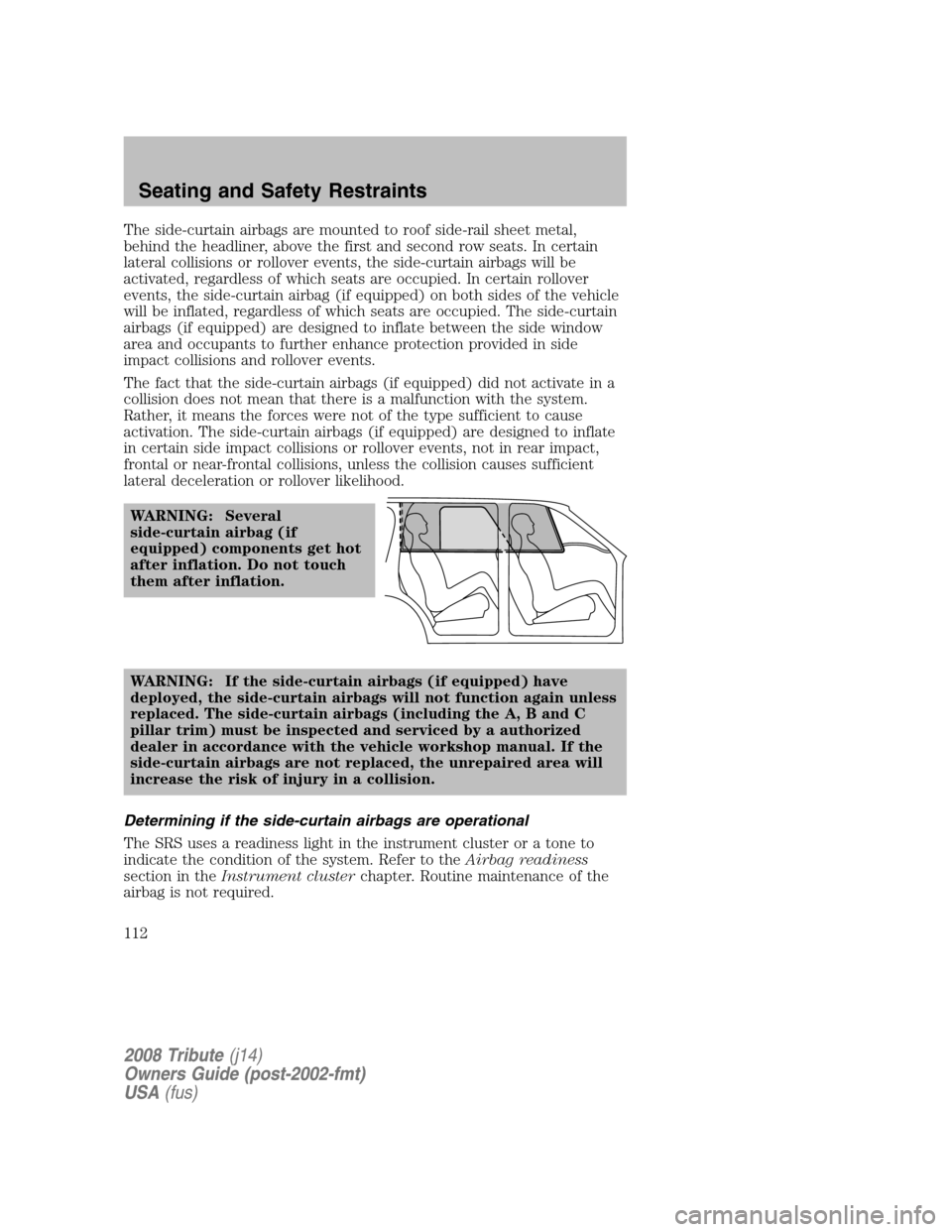
The side-curtain airbags are mounted to roof side-rail sheet metal,
behind the headliner, above the first and second row seats. In certain
lateral collisions or rollover events, the side-curtain airbags will be
activated, regardless of which seats are occupied. In certain rollover
events, the side-curtain airbag (if equipped) on both sides of the vehicle
will be inflated, regardless of which seats are occupied. The side-curtain
airbags (if equipped) are designed to inflate between the side window
area and occupants to further enhance protection provided in side
impact collisions and rollover events.
The fact that the side-curtain airbags (if equipped) did not activate in a
collision does not mean that there is a malfunction with the system.
Rather, it means the forces were not of the type sufficient to cause
activation. The side-curtain airbags (if equipped) are designed to inflate
in certain side impact collisions or rollover events, not in rear impact,
frontal or near-frontal collisions, unless the collision causes sufficient
lateral deceleration or rollover likelihood. WARNING: Several
side-curtain airbag (if
equipped) components get hot
after inflation. Do not touch
them after inflation.
WARNING: If the side-curtain airbags (if equipped) have
deployed, the side-curtain airbags will not function again unless
replaced. The side-curtain airbags (including the A, B and C
pillar trim) must be inspected and serviced by a authorized
dealer in accordance with the vehicle workshop manual. If the
side-curtain airbags are not replaced, the unrepaired area will
increase the risk of injury in a collision.
Determining if the side-curtain airbags are operational
The SRS uses a readiness light in the instrument cluster or a tone to
indicate the condition of the system. Refer to the Airbag readiness
section in the Instrument cluster chapter. Routine maintenance of the
airbag is not required.
2008 Tribute (j14)
Owners Guide (post-2002-fmt)
USA (fus)
Seating and Safety Restraints
112
Page 113 of 288
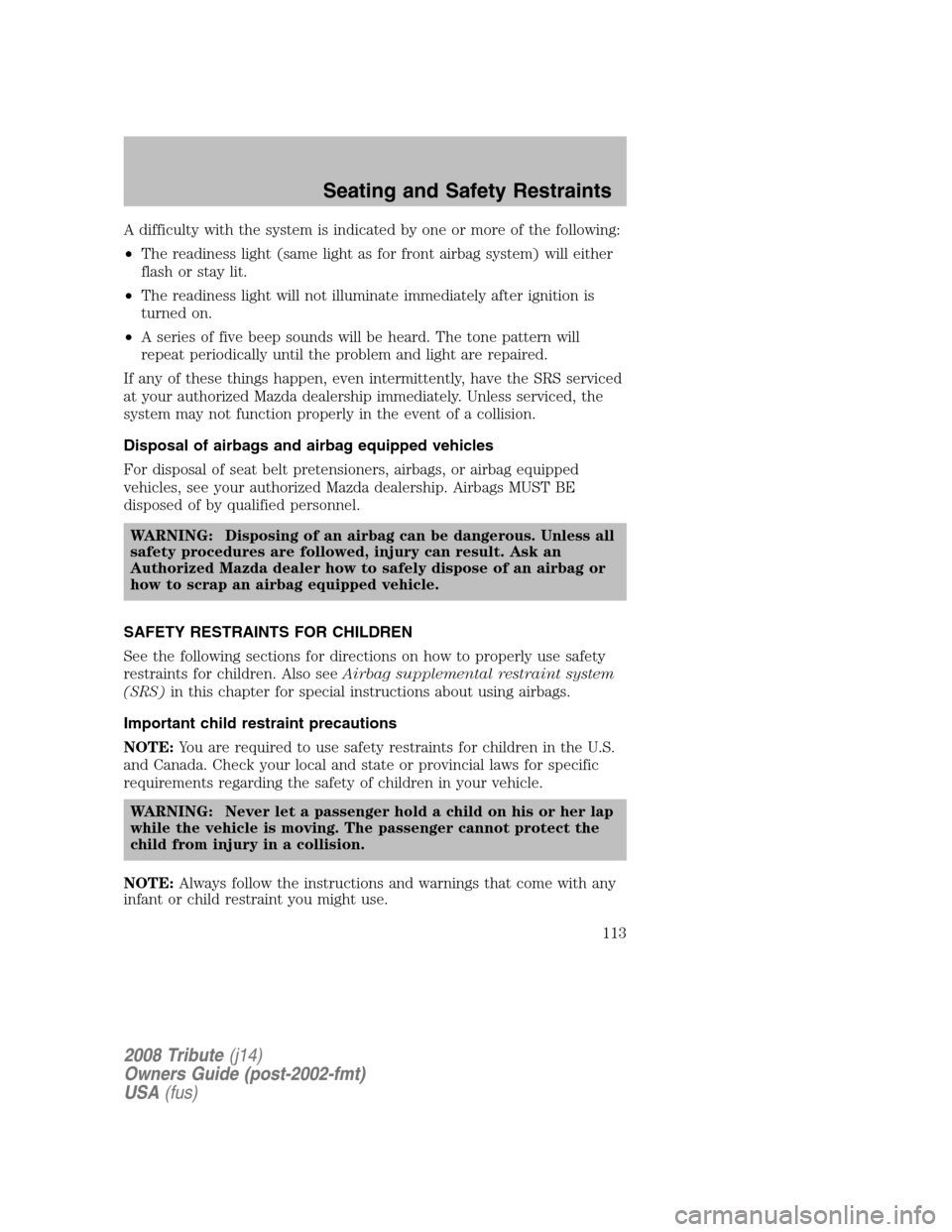
A difficulty with the system is indicated by one or more of the following:
• The readiness light (same light as for front airbag system) will either
flash or stay lit.
• The readiness light will not illuminate immediately after ignition is
turned on.
• A series of five beep sounds will be heard. The tone pattern will
repeat periodically until the problem and light are repaired.
If any of these things happen, even intermittently, have the SRS serviced
at your authorized Mazda dealership immediately. Unless serviced, the
system may not function properly in the event of a collision.
Disposal of airbags and airbag equipped vehicles
For disposal of seat belt pretensioners, airbags, or airbag equipped
vehicles, see your authorized Mazda dealership. Airbags MUST BE
disposed of by qualified personnel.
WARNING: Disposing of an airbag can be dangerous. Unless all
safety procedures are followed, injury can result. Ask an
Authorized Mazda dealer how to safely dispose of an airbag or
how to scrap an airbag equipped vehicle.
SAFETY RESTRAINTS FOR CHILDREN
See the following sections for directions on how to properly use safety
restraints for children. Also see Airbag supplemental restraint system
(SRS) in this chapter for special instructions about using airbags.
Important child restraint precautions
NOTE: You are required to use safety restraints for children in the U.S.
and Canada. Check your local and state or provincial laws for specific
requirements regarding the safety of children in your vehicle.
WARNING: Never let a passenger hold a child on his or her lap
while the vehicle is moving. The passenger cannot protect the
child from injury in a collision.
NOTE: Always follow the instructions and warnings that come with any
infant or child restraint you might use.
2008 Tribute (j14)
Owners Guide (post-2002-fmt)
USA (fus)
Seating and Safety Restraints
113
Page 114 of 288
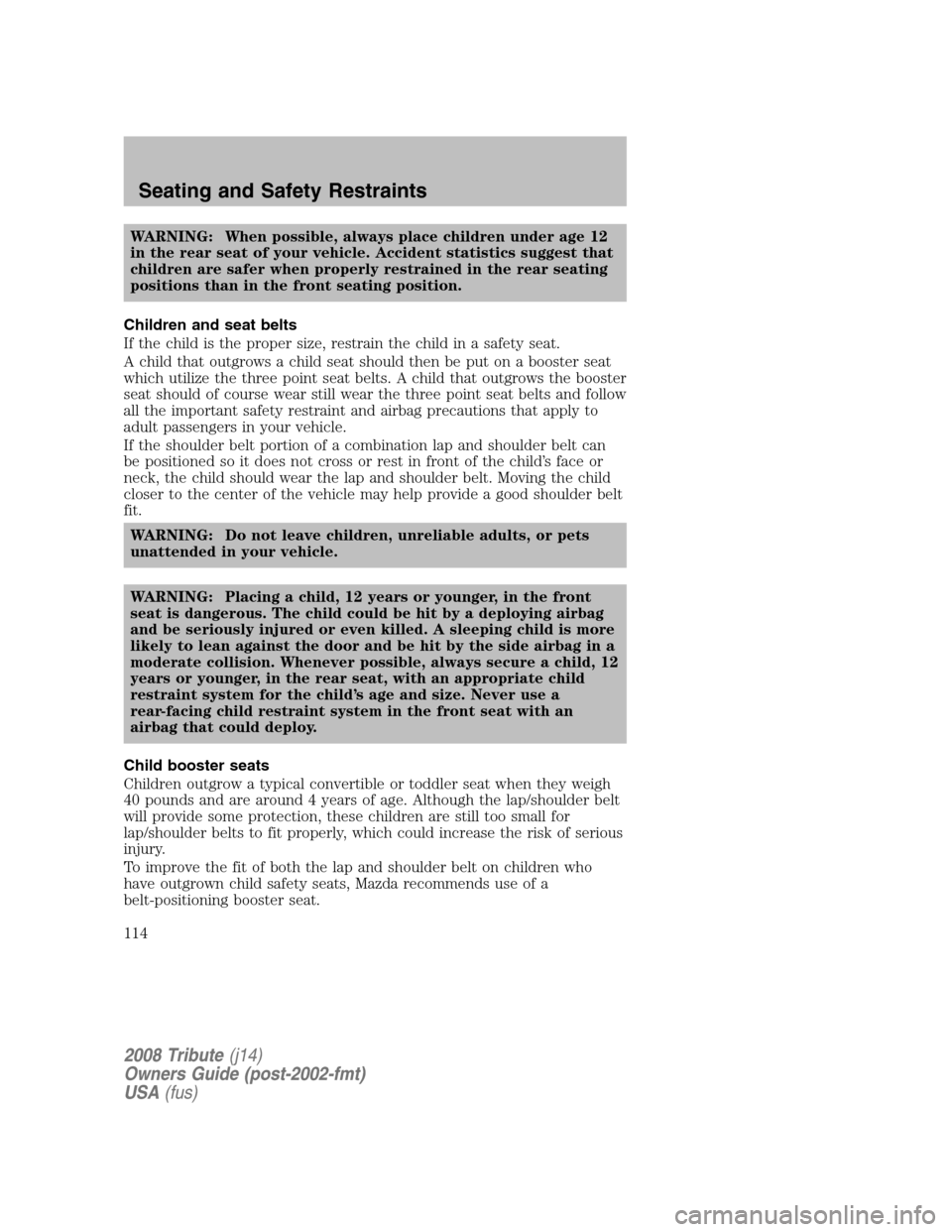
WARNING: When possible, always place children under age 12
in the rear seat of your vehicle. Accident statistics suggest that
children are safer when properly restrained in the rear seating
positions than in the front seating position.
Children and seat belts
If the child is the proper size, restrain the child in a safety seat.
A child that outgrows a child seat should then be put on a booster seat
which utilize the three point seat belts. A child that outgrows the booster
seat should of course wear still wear the three point seat belts and follow
all the important safety restraint and airbag precautions that apply to
adult passengers in your vehicle.
If the shoulder belt portion of a combination lap and shoulder belt can
be positioned so it does not cross or rest in front of the child’s face or
neck, the child should wear the lap and shoulder belt. Moving the child
closer to the center of the vehicle may help provide a good shoulder belt
fit. WARNING: Do not leave children, unreliable adults, or pets
unattended in your vehicle.
WARNING: Placing a child, 12 years or younger, in the front
seat is dangerous. The child could be hit by a deploying airbag
and be seriously injured or even killed. A sleeping child is more
likely to lean against the door and be hit by the side airbag in a
moderate collision. Whenever possible, always secure a child, 12
years or younger, in the rear seat, with an appropriate child
restraint system for the child’s age and size. Never use a
rear-facing child restraint system in the front seat with an
airbag that could deploy.
Child booster seats
Children outgrow a typical convertible or toddler seat when they weigh
40 pounds and are around 4 years of age. Although the lap/shoulder belt
will provide some protection, these children are still too small for
lap/shoulder belts to fit properly, which could increase the risk of serious
injury.
To improve the fit of both the lap and shoulder belt on children who
have outgrown child safety seats, Mazda recommends use of a
belt-positioning booster seat.
2008 Tribute (j14)
Owners Guide (post-2002-fmt)
USA (fus)
Seating and Safety Restraints
114
Page 115 of 288
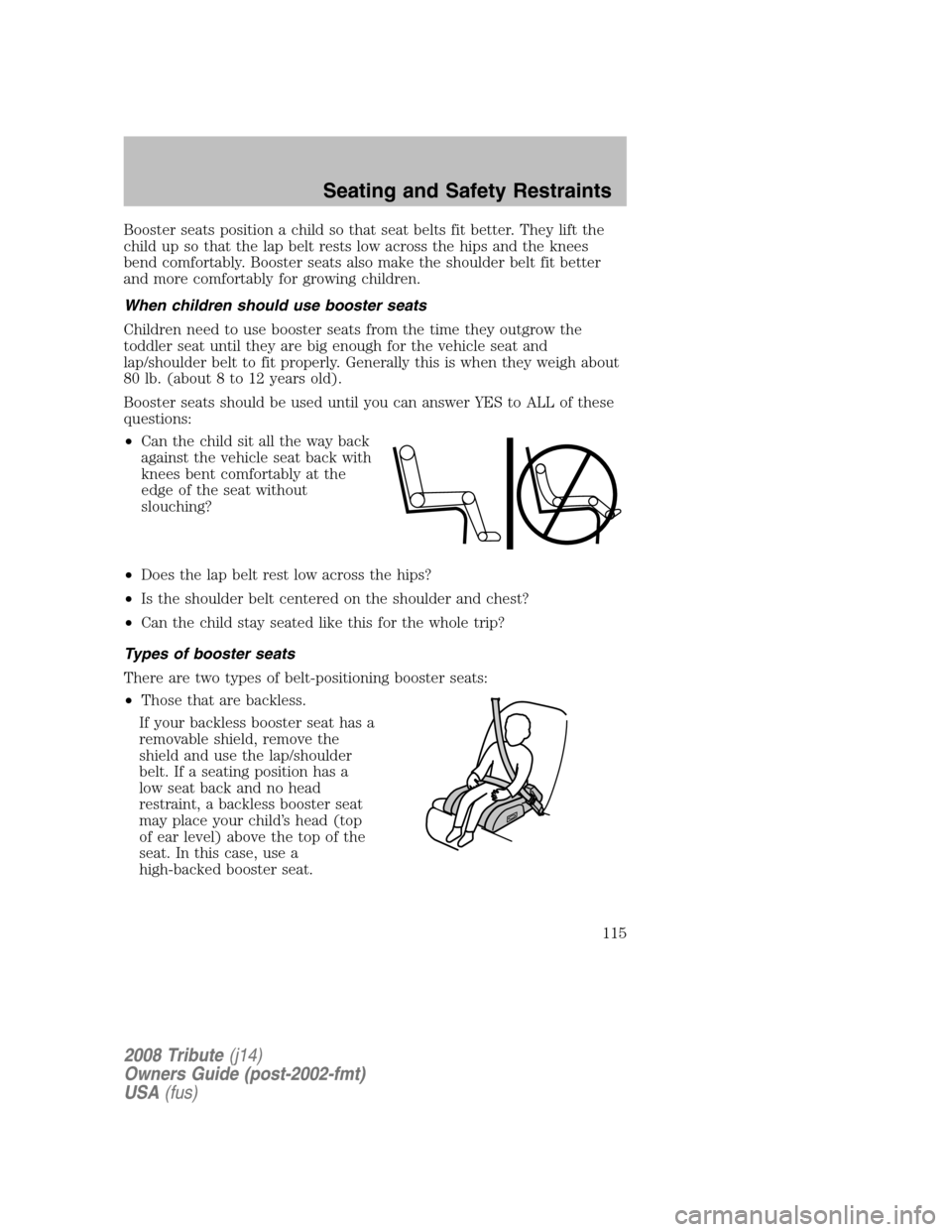
Booster seats position a child so that seat belts fit better. They lift the
child up so that the lap belt rests low across the hips and the knees
bend comfortably. Booster seats also make the shoulder belt fit better
and more comfortably for growing children.
When children should use booster seats
Children need to use booster seats from the time they outgrow the
toddler seat until they are big enough for the vehicle seat and
lap/shoulder belt to fit properly. Generally this is when they weigh about
80 lb. (about 8 to 12 years old).
Booster seats should be used until you can answer YES to ALL of these
questions:
• Can the child sit all the way back
against the vehicle seat back with
knees bent comfortably at the
edge of the seat without
slouching?
• Does the lap belt rest low across the hips?
• Is the shoulder belt centered on the shoulder and chest?
• Can the child stay seated like this for the whole trip?
Types of booster seats
There are two types of belt-positioning booster seats:
• Those that are backless.
If your backless booster seat has a
removable shield, remove the
shield and use the lap/shoulder
belt. If a seating position has a
low seat back and no head
restraint, a backless booster seat
may place your child’s head (top
of ear level) above the top of the
seat. In this case, use a
high-backed booster seat.
2008 Tribute (j14)
Owners Guide (post-2002-fmt)
USA (fus)
Seating and Safety Restraints
115
Page 116 of 288
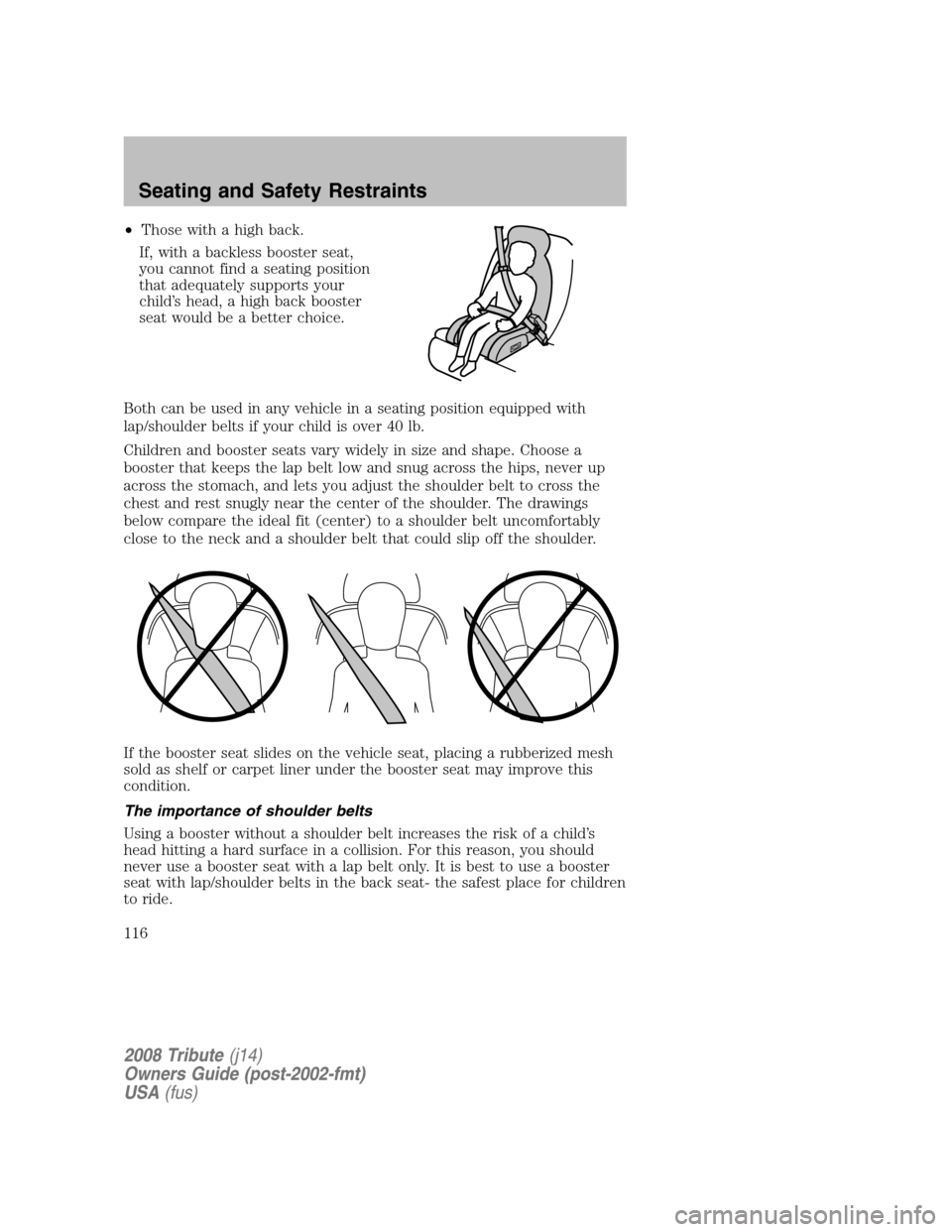
•Those with a high back.
If, with a backless booster seat,
you cannot find a seating position
that adequately supports your
child’s head, a high back booster
seat would be a better choice.
Both can be used in any vehicle in a seating position equipped with
lap/shoulder belts if your child is over 40 lb.
Children and booster seats vary widely in size and shape. Choose a
booster that keeps the lap belt low and snug across the hips, never up
across the stomach, and lets you adjust the shoulder belt to cross the
chest and rest snugly near the center of the shoulder. The drawings
below compare the ideal fit (center) to a shoulder belt uncomfortably
close to the neck and a shoulder belt that could slip off the shoulder.
If the booster seat slides on the vehicle seat, placing a rubberized mesh
sold as shelf or carpet liner under the booster seat may improve this
condition.
The importance of shoulder belts
Using a booster without a shoulder belt increases the risk of a child’s
head hitting a hard surface in a collision. For this reason, you should
never use a booster seat with a lap belt only. It is best to use a booster
seat with lap/shoulder belts in the back seat- the safest place for children
to ride.
2008 Tribute (j14)
Owners Guide (post-2002-fmt)
USA (fus)
Seating and Safety Restraints
116
Page 117 of 288
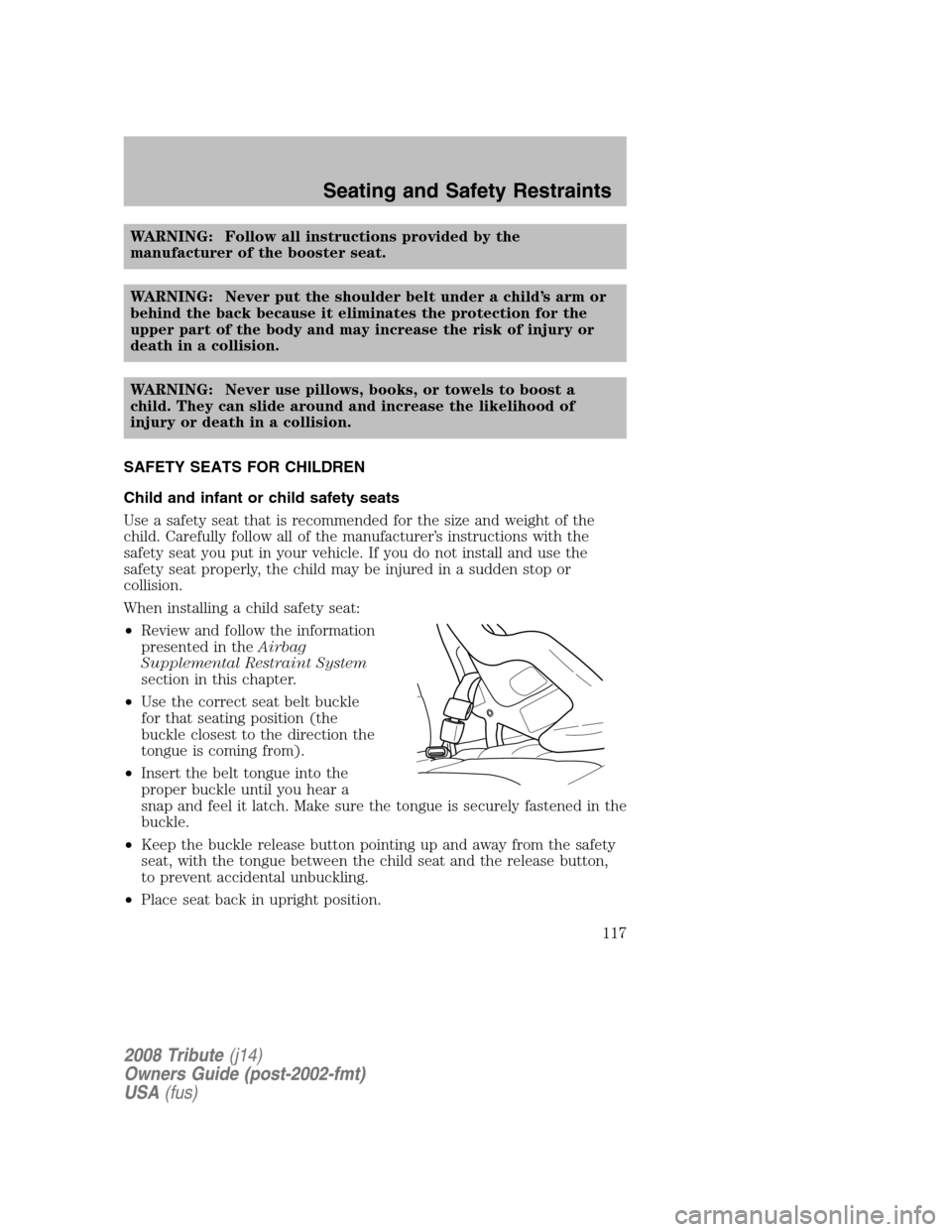
WARNING: Follow all instructions provided by the
manufacturer of the booster seat.
WARNING: Never put the shoulder belt under a child’s arm or
behind the back because it eliminates the protection for the
upper part of the body and may increase the risk of injury or
death in a collision.
WARNING: Never use pillows, books, or towels to boost a
child. They can slide around and increase the likelihood of
injury or death in a collision.
SAFETY SEATS FOR CHILDREN
Child and infant or child safety seats
Use a safety seat that is recommended for the size and weight of the
child. Carefully follow all of the manufacturer’s instructions with the
safety seat you put in your vehicle. If you do not install and use the
safety seat properly, the child may be injured in a sudden stop or
collision.
When installing a child safety seat:
• Review and follow the information
presented in the Airbag
Supplemental Restraint System
section in this chapter.
• Use the correct seat belt buckle
for that seating position (the
buckle closest to the direction the
tongue is coming from).
• Insert the belt tongue into the
proper buckle until you hear a
snap and feel it latch. Make sure the tongue is securely fastened in the
buckle.
• Keep the buckle release button pointing up and away from the safety
seat, with the tongue between the child seat and the release button,
to prevent accidental unbuckling.
• Place seat back in upright position.
2008 Tribute (j14)
Owners Guide (post-2002-fmt)
USA (fus)
Seating and Safety Restraints
117
Page 118 of 288
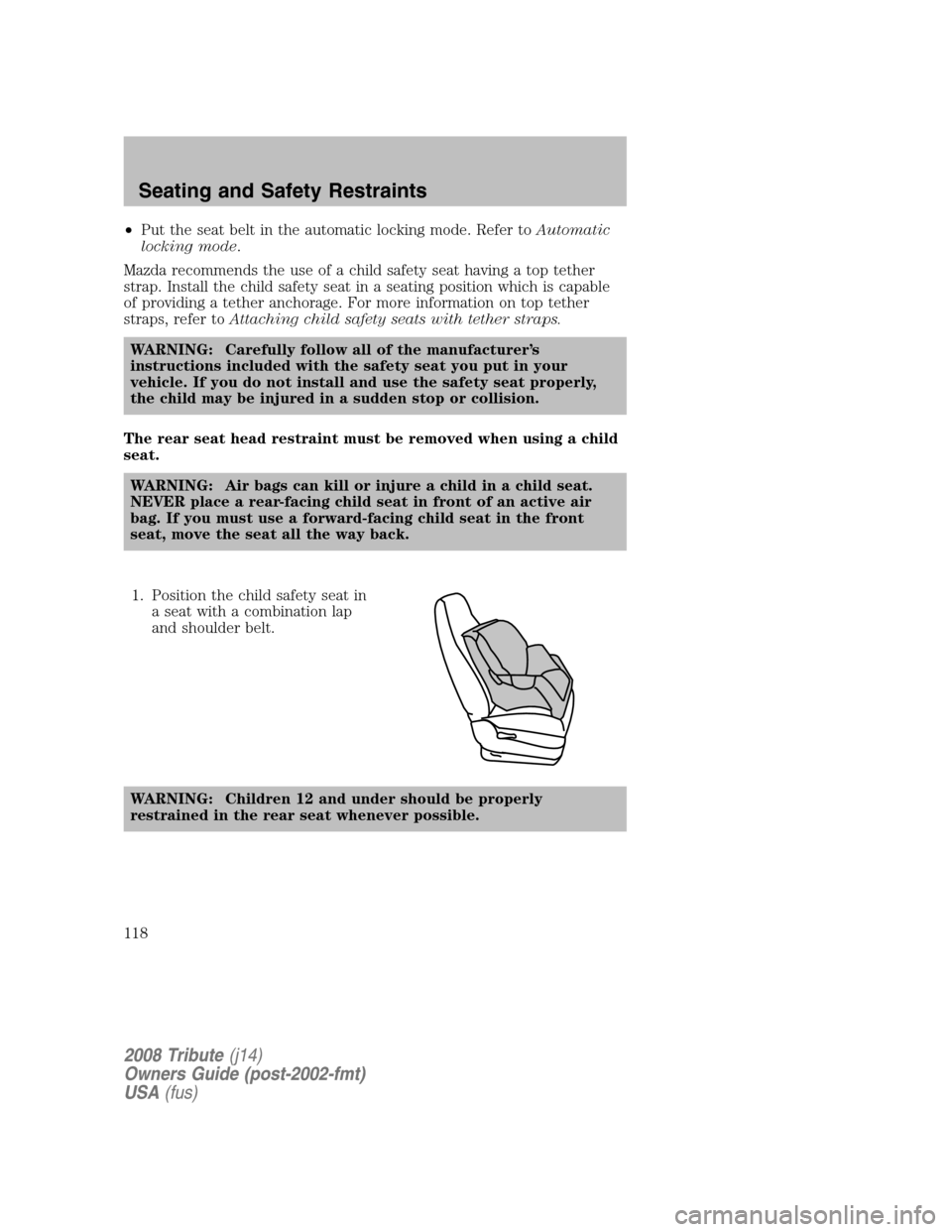
•Put the seat belt in the automatic locking mode. Refer to Automatic
locking mode .
Mazda recommends the use of a child safety seat having a top tether
strap. Install the child safety seat in a seating position which is capable
of providing a tether anchorage. For more information on top tether
straps, refer to Attaching child safety seats with tether straps.
WARNING: Carefully follow all of the manufacturer’s
instructions included with the safety seat you put in your
vehicle. If you do not install and use the safety seat properly,
the child may be injured in a sudden stop or collision.
The rear seat head restraint must be removed when using a child
seat. WARNING: Air bags can kill or injure a child in a child seat.
NEVER place a rear-facing child seat in front of an active air
bag. If you must use a forward-facing child seat in the front
seat, move the seat all the way back.
1. Position the child safety seat in a seat with a combination lap
and shoulder belt.
WARNING: Children 12 and under should be properly
restrained in the rear seat whenever possible.
2008 Tribute (j14)
Owners Guide (post-2002-fmt)
USA (fus)
Seating and Safety Restraints
118
Page 119 of 288
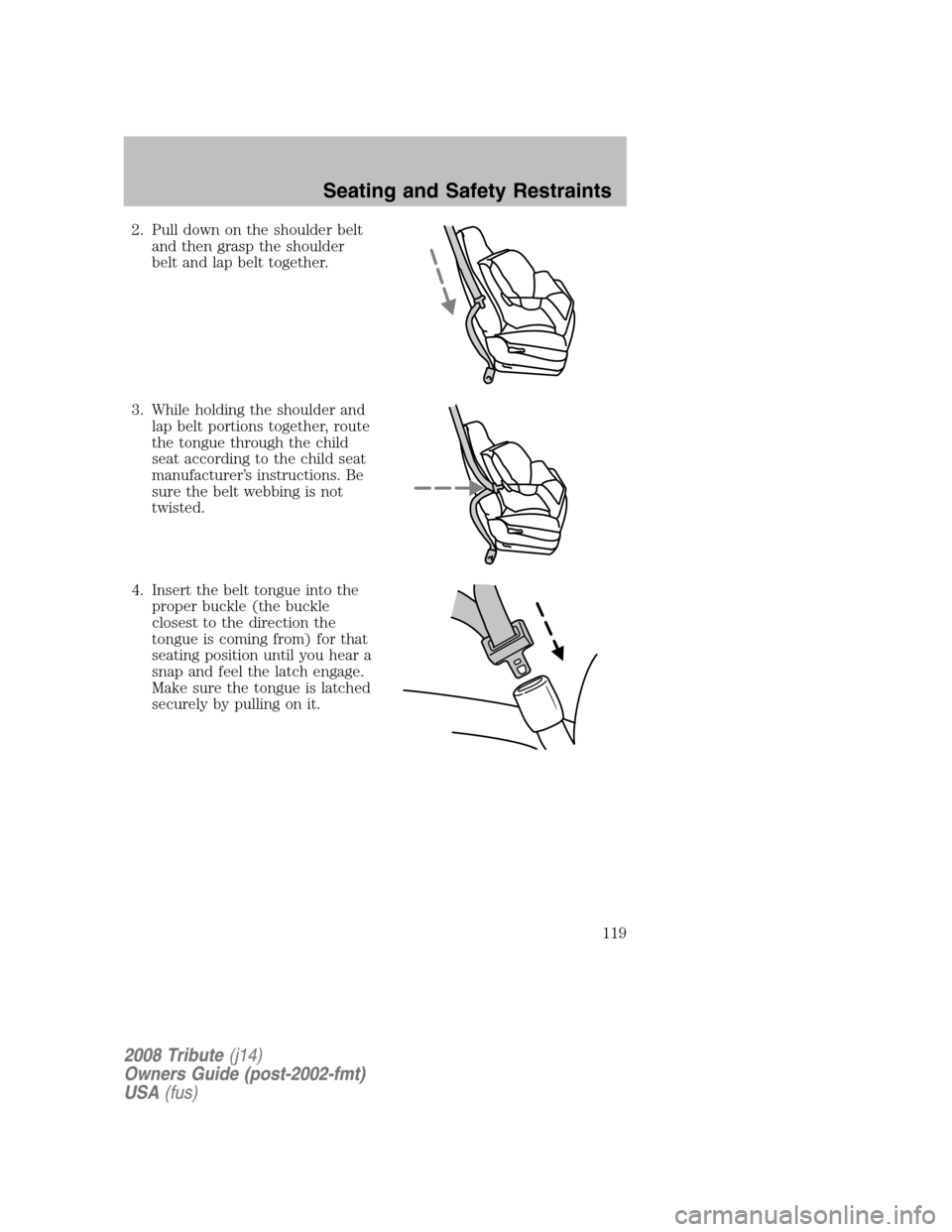
2. Pull down on the shoulder belt and then grasp the shoulder
belt and lap belt together.
3. While holding the shoulder and lap belt portions together, route
the tongue through the child
seat according to the child seat
manufacturer’s instructions. Be
sure the belt webbing is not
twisted.
4. Insert the belt tongue into the proper buckle (the buckle
closest to the direction the
tongue is coming from) for that
seating position until you hear a
snap and feel the latch engage.
Make sure the tongue is latched
securely by pulling on it.
2008 Tribute (j14)
Owners Guide (post-2002-fmt)
USA (fus)
Seating and Safety Restraints
119
Page 120 of 288
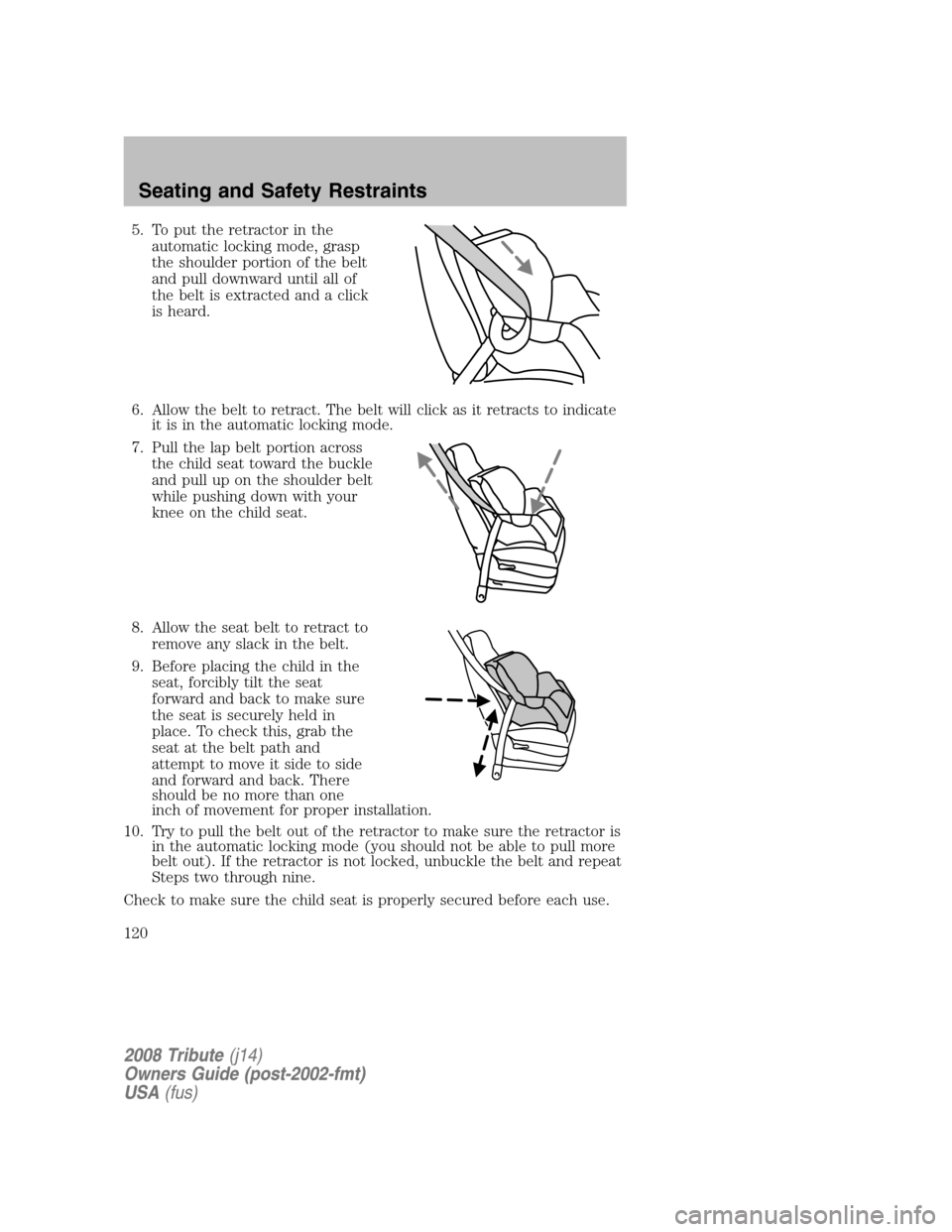
5. To put the retractor in the automatic locking mode, grasp
the shoulder portion of the belt
and pull downward until all of
the belt is extracted and a click
is heard.
6. Allow the belt to retract. The belt will click as it retracts to indicate it is in the automatic locking mode.
7. Pull the lap belt portion across the child seat toward the buckle
and pull up on the shoulder belt
while pushing down with your
knee on the child seat.
8. Allow the seat belt to retract to remove any slack in the belt.
9. Before placing the child in the seat, forcibly tilt the seat
forward and back to make sure
the seat is securely held in
place. To check this, grab the
seat at the belt path and
attempt to move it side to side
and forward and back. There
should be no more than one
inch of movement for proper installation.
10. Try to pull the belt out of the retractor to make sure the retractor is in the automatic locking mode (you should not be able to pull more
belt out). If the retractor is not locked, unbuckle the belt and repeat
Steps two through nine.
Check to make sure the child seat is properly secured before each use.
2008 Tribute (j14)
Owners Guide (post-2002-fmt)
USA (fus)
Seating and Safety Restraints
120